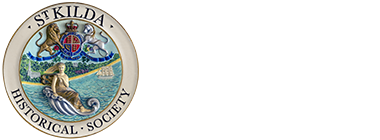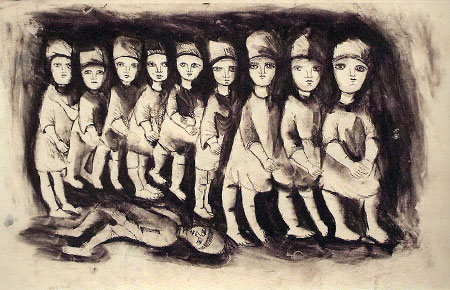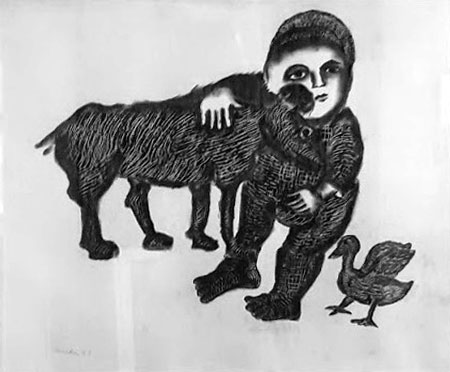Presciently, the Moras stayed in St Kilda Road when they arrived in July 1951. A series of fortunate coincidences lead them to ren an apartment at 9 Collins Street, already known as the 'Paris end' of Collins Street. Grosvenor Chambers was built in 1888 to accommodate artist studios and its illustrious tenants included Tom Roberts, Jane Sutherland, Arthur Streeton and Clara Southern, all members of the Heidelberg School.
Presciently, the Moras stayed in St Kilda Road when they arrived in July 1951. A series of fortunate coincidences lead them to rent an apartment at 9 Collins Street, already known as the ‘Paris end’ of Collins Street. Grosvenor Chambers was built in 1888 to accommodate artist studios and its illustrious tenants included Tom Roberts, Jane Sutherland, Arthur Streeton and Clara Southern, all members of the Heidelberg School.
Through Mirka and Georges’ growing intimacy with cultural figures such as John and Sunday Reed, Joy Hester, Ian and Dawn Sime, Charles and Barbara Blackman, John Perceval and Mary Boyd, as well as poet Barrett Reid, they found themselves at the centre of modernist discourse and artmaking. It inspired Mirka who, without any formal training, committed herself to painting. In 1953, the Moras’ apartment hosted the first meeting of the revived Contemporary Art Society. The Mirka Cafe opened in Exhibition Street the following year and the Balzac, a successful French bistro, was launched in 1956 to coincide with the wave of international tourism from the Olympic Games.
Mirka was a stunningly attractive young woman. Her chic fashion sense, gamine hair style together with a radiant smile, mischievous manner, and genuine warmth and sympathy made her probably the most interesting woman in town. The phrase joie de vivre could have been invented for her. She seduced Melbourne – with her naughty sense of humour I believe she’d like that description – in the nicest possible way. She was also a woman of prodigious energy, capable of running a restaurant, being a mother and exploring her destiny as an artist. As Ross Lansell comments, ‘Mirka would work 48 hours a day if she could. She was a workaholic. She would go on and on without ever feeding herself’. (17)
It must have been a surprise for their Australian friends – most of whom desperately wanted to flee the antipodes for Europe – to meet French intellectuals who had abandoned it. The Moras did not emphasise their Jewish roots, or the trauma of war. Did they wish to lay the past to rest? Did they feel they might encounter prejudice here? Tellingly, they did not teach their children to speak French. (As a child, I recall hearing other languages spoken on the tram or in the street by emigrants who were labelled ‘dagos’.) When Georges became a gallery director, his trips to the continent were frequent. Mirka, however, was reluctant. I often asked her why – why not visit home? She hadn’t forgotten her French and her voice carried a deliciously distinctive accent. But Mirka – usually so forthright and articulate, so full of spirit - never quite seemed to have a definite answer. I felt she was putting it off. (18) Perhaps the ghosts of the camps had rendered France a cemetery.
See more of the Mirka Mora Project
Credits
{slider-ex title="Author" open="false" class="icon"}
Dr Janine Burke is an author, art historian and a local resident for thirty-five years. She is Honorary Senior Fellow, University of Melbourne and committee member, St Kilda Historical Society.
{slider-ex title="Notes" class="icon"}
{slider title="From Paris to Melbourne" open="false"}
- Albert Tucker to Sunday Reed. 31 January, 1951. John and Sunday Reed Papers, State Library of Victoria.
- Albert Tucker to John and Sunday Reed. 27 August, 1950. John and Sunday Reed Papers, State Library of Victoria.
- Mirka Mora, Wicked but Virtuous: My Life, Viking, Ringwood, 2000, p.13.
- Pithiviers station is undergoing transformation as a Holocaust museum. See Melian Solly. ‘Museum to be built at Site of Nazi Occupied France’s First Concentration Camp’, December 18, 2018. https://www.smithsonianmag.com/smart-news/museum-built-site-nazi-occupied-frances-first-concentration-camp-set-open-2020-180971126/ Accessed 1 July 2019.
- Mora, Wicked but Virtuous, p.15.
- Zelda Cawthorne, ‘Treasure Trove of Mirka’, 18 June, 2014. https://www.jewishnews.net.au/treasure-trove-from-mirka/35684 Accessed 2 July 2019.
- Mora, Wicked but Virtuous, p.15.
- Mora, Wicked but Virtuous, p.20.
- Lesley Alway and Kendrah Morgan, Mirka and Georges, A Culinary Affair, The Miegunyah Press, Heide Musuem of Modern Art, 2018, p. 21.
- For a description of the history and activities of the Oeuvre de secours aux enfants see https://www.ose-france.org/wp-content/uploads/2014/12/Bochure-100-ans-OSE-anglais.pdf Accessed 4 January 2020.
- Georges’ heroic activities in OSE are described in Monsieur Mayonnaise (2016). Documentary film. Philippe Mora, narrator. Trevor Graham, writer and director. Trevor Graham, Ned Lander and Lisa Wang producers, Antidote Films.
- Mora, Wicked but Virtuous, p.40.
- Mora, Wicked but Virtuous, p.25.
- Quoted in Dianne Reilly, ‘Antoine Fauchery, 1823–1861 Photographer and Journalist Par Excellence’, La Trobe Journal, no 33, April 1984, p.3, fn 9. http://www3.slv.vic.gov.au/latrobejournal/issue/latrobe-33/t1-g-t1.html. Accessed 3 July 2019. While following cash and adventure to Japan, Fauchery died in Yokohama in 1861, due to complications from dysentery. He was 37.
- Mora, Wicked but Virtuous, p.159.
- Mora, Wicked but Virtuous, p.48.
{slider title="Paris End of Collins Street - 1950s"}
- G.R. Lansell, Email to the author, 15 June 2019.
- In 1992, Mirka travelled to France to teach a workshop titled Adventure in Art: Mirka en Provence which included a stint at Saint-Paul-de-Vence on the French Riviera. Organised by John and Shirley Traynor, it took place shortly after Georges died. The group spent time in Paris, Mirka noting, ‘of course [the tour] included almost all the places I had been with my husband’. Mora, Wicked but Virtuous, p.219. In 1994, Mirka travelled to France when Philippe Mora, based in Los Angeles, invited her to attend the Cannes film festival with him.
{slider title="St Kilda, Fitzroy Street (Tolarno) 1966-1970"}
- Jackie Somerville. Telephone interview with the author. 22 May 2020.
- Judith Buckrich, Acland Street, The Grand Lady of St Kilda, Australian Teachers of Media, St Kilda, 2017, p. 110.
- Buckrich, Acland Street, p.101.
- Mora, Wicked but Virtuous, p. 85.
- Mora, Wicked but Virtuous, p.87. The original 1966 mural is in the collection of Heide Museum of Modern Art.
- Mora, Wicked but Virtuous, p.86. The room which Mirka first occupied on the ground floor as her studio was appropriated by Georges for Tolarno Gallery, so Mirka moved into the basement where she had three rooms. On the first floor, she had a bedroom separate from Georges which also served as a smaller studio.
- Richard Peterson, ‘Tolarno Hotel’, in A Place of Sensuous Resort. St Kilda Buildings and Their People, Chapter 17, p.5. http://www.richardpeterson.com.au/a-place-of-sensuous-resort. Accessed 4 July 2019.
- For an overview of the history of the Tolarno from its building to the 1970s see Peterson, A Place of Sensuous Resort. Chapter 17, pp.5-8. http://www.richardpeterson.com.au/a-place-of-sensuous-resort.
- Tricia Goodwin, ‘Love Among the Ruins’, The Herald, 28 November, 1968, p.21.
- It’s unlikely Mirka read Death at the End of the World available in the original French edition. If she had, she would have known that Lionel and Céleste’s home was a five room ‘chalet...made of pine with a galvanised-iron roof’ in St Kilda. Patricia Clancy and Jeanne Allen, Introduction and translation, The French Consul’s Wife, Memoirs of Céleste de Chabrillan in Gold-rush Australia, The Miegunyah Press, Melbourne, 1998, p.113.
- ‘We have found some land two leagues (around 10 kilometres) from the town in the heart of the woods, near a village called Saint-Kilda (sic). We are going to erect the house that I bought in Bordeaux on this site’. Clancy and Allen, The French Consul’s Wife, p.95.
- Clancy and Allen, The French Consul’s Wife, p.95.
- Fauchery’s letter, dated 4 February 1859, is quoted in full in Clancy and Allen, The French Consul’s Wife, pp.237-242.
- Mirka Mora to Sunday Reed. 10 March 1967. John and Sunday Reed Papers, State Library of Victoria. MS 13186. 2.20. Mirka Mora Correspondence.
- Sweeney Reed (1945-1979) was the adopted son of John and Sunday Reed. Sweeney was the son of the marriage of Joy Hester and Albert Tucker. In 1967, Sweeney was director of Strines, a gallery in Carlton.
- G.R. Lansell. Email to the author, 16 December 2019.
- Mora, Wicked but Virtuous, pp. 165-166.
- Mora, Wicked but Virtuous, p.169.
- Bernard Smith, Australian Painting, Oxford University Press, London, 1971, p. 312.
- Janine Burke ‘Donald Laycock’, Art and Australia, October – December 1975, Vol 13, No 2, pp. 144-151.
- G.R. Lansell. Email to the author, 16 December 2019.
- Georges Mora to Sunday Reed. 27 December 1970. John and Sunday Reed Papers, State Library of Victoria. MS 13186, Box 2/18, File 7.
- Mora to Reed. 27 December 1970. John and Sunday Reed Papers, State Library of Victoria. MS 13186, Box 2/18, File 7.
- Mora, Wicked but Virtuous, pp.166-167.
- Mora, Wicked but Virtuous, p.163.
- G.R. Lansell. Email to the author, 16 December 2019.
- Mora’s scrapbook is in the collection of Heide Museum of Modern Art.
- Sheila Sibley, ‘And art was her choice’, Sunday Observer, 21 June, 1970. Interestingly, Mirka included the same anecdote in her autobiography Wicked but Virtuous: My Life (2000) indicating the potency of Chevalier’s question and her answer. See Mora, Wicked but Virtuous, p.77.
- Keith Dunstan, ‘A Place in the Sun’, The Sun, 4 June 1971.
- Janine Burke (ed), Dear Sun: the letters of Joy Hester and Sunday Reed, William Heinemann Australia, Melbourne 1995, p.203.
- Mora, Wicked but Virtuous, p.54.
{slider title="St Kilda, Wellington Street 1970-1975"}
- The shopfront-dwelling at 26 Wellington Street was demolished to make way for a block of units.
- Sheila Sibley, ‘And art was her choice’, Sunday Observer, June 21, 1970.
- Sheila Sibley, ‘And art was her choice’, Sunday Observer, June 21, 1970.
- Janine Burke and Lynne Cook, ‘Mirka Mora’, Farrago, April 26, 1974, p.11.
- Transcript of interview with Mirka Mora by Barrett Reid, 14 January 1971, p.21. Barrett Reid Papers, State Library of Victoria. MS 13339, Box 9, File 2, Wallet 1/1.
- Sabine Cotte, Mirka Mora: A life making art, Thames and Hudson, Melbourne, 2019, p. 80.
- Mora, Wicked but Virtuous, p.156.
- Jane Freeman, ‘Mora’s magic in full bloom’, Sydney Morning Herald, 6 September, 1996, p.14.
- Mora, Wicked but Virtuous, pp. 147-148.
- Burke and Cook, ‘Mirka Mora’, Farrago, p.11.
- Mora, Wicked but Virtuous, p. 148.
- Jenny Kee with Samantha Trenoweth, A Big Life, Lantern, Melbourne, p.132.
{slider title="St Kilda, Barkly Street 1981-1999 and beyond"}
- Mirka Mora to Janine Burke, 2 November 1981. Mirka Mora Papers. Box 3, Correspondence. Brown Envelope 11. Heide Museum of Modern Art.
- William Mora. Telephone conversation with the author. 6 November 2019.
- Mora to Burke, 2 November 1981. Mirka Mora Papers, Box 3, Correspondence. Brown Envelope 11. Heide Museum of Modern Art.
- Mora, Wicked but Virtuous, pp.53-54.
- Bridie Carter. Email to the author. April 16, 2019.
- Mora, Wicked but Virtuous, p.299.
- Mora, Wicked but Virtuous, p.300.
- Mora, Wicked but Virtuous, p.300.
- Rachel Berger, ‘Memories of Mirka’, St Kilda News, Issue 81, October-November 2018, p. 21.
- Mora, Wicked but Virtuous, p. 149.
- Helen Halliday, ‘Memories of Mirka’, St Kilda News, Issue 81, October-November 2018, p.19.
- Halliday, ‘Memories of Mirka’, St Kilda News, p.19.
- Mora, Wicked but Virtuous, p. 152.
- Ann Holt, ‘Memories of Mirka’, St Kilda News, Issue 81, October-November 2018, p.16.
- Gail Donovan, ‘Memories of Mirka’, St Kilda News, Issue 81, October-November 2018, p.18.
- Donovan, ‘Memories of Mirka’, St Kilda News, p.18.
- Ross Lansell remembers it rather differently. ‘Gail and Kevin very generously provided us two with a late impromptu Christmas lunch for free (also from memory, not exactly for the first time). I remember shortly thereafter personally delivering to Gail and Kevin (Mirka wasn’t present) a modest gouache...to thank them’. G.R.Lansell. Email to the author. October 31, 2019.
- Mora, Wicked but Virtuous, p.242.
- Cotte, Mirka Mora: A life making art, p.177. Cotte was also responsible for the conservation of Mora’s Flinders Street Station mosaic. She worked on it in March 2009, then again in November 2010.
- Cotte, Mirka Mora: A life making art, p.177.
- Cotte, Mirka Mora: A life making art, p.177.
- Mora, Wicked but Virtuous, p.243.
- Tolarno Gallery is now at Level 4, 101 Exhibition Street, Melbourne (at time of writing) and its director is Jan Minchin who joined Georges as assistant director in the late 1970s.
- Guy Grossi, ‘Memories of Mirka’, St Kilda News, Issue 81, October-November 2018, p.18.
- G.R.Lansell. Email to the author. 16 December 2019.
- Serge Thomann. Email to the author. 6 November 2019.
- Serge Thomann. Email to the author. 6 November 2019.
- Jane Touzeau. Email to the author. 5 January 2020.
{slider title="Epilogue"}
- Mora, Wicked but Virtuous, pp. 299-302.
{/sliders-ex}
{/sliders}





